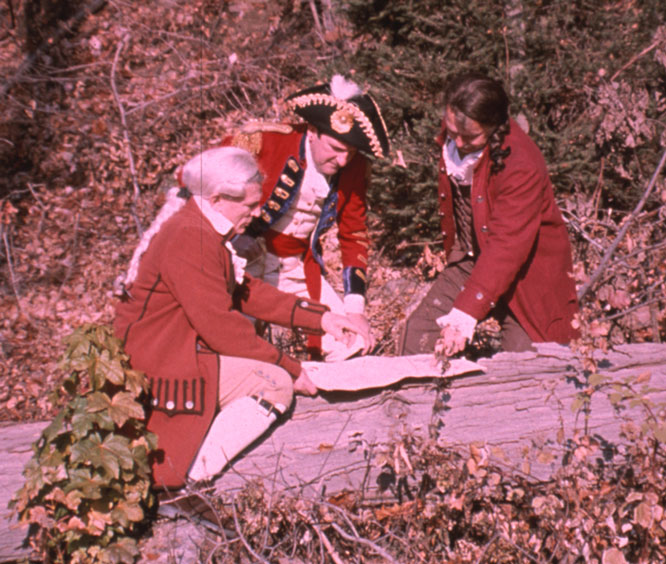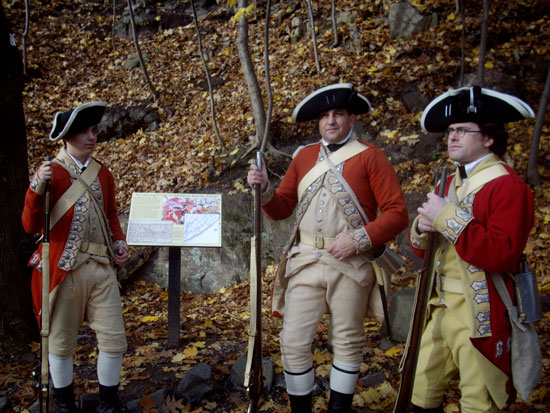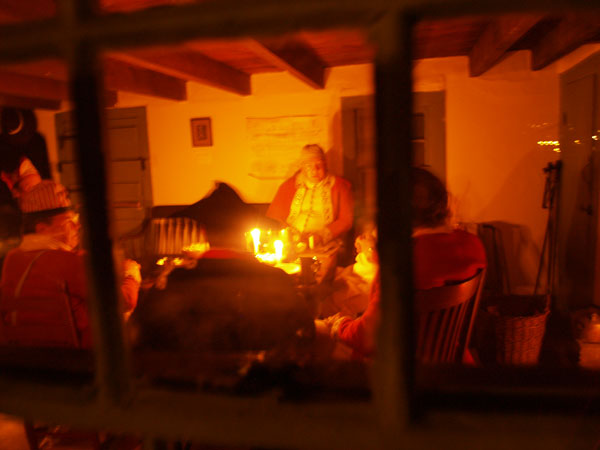On His Lordship’s Mysterious Ascent
A “Cliff Notes” Story
November 1998
You can also view a video adaptation of this story (created in February 2023)!
In the pre-dawn darkness of November 20, 1776, a wooden keel scrapes against a crude stone jetty in Hudson’s River — and the invasion of New Jersey begins.
The cold, intermittent rain that started overnight continues as hour after hour boats land at the base of the tall stone escarpment. Armed men — British regulars, “Hessians” from the distant German states, their officers — disembark to climb the primitive “road” to the summit. Dawn will reveal dozens of boats still queued on the river, protected by warships looming from the mist like prickly wooden isles.
Those troops already on the steep defile feel vulnerable, anxious to reach the top. For many, this is their first taste of real wilderness. They watch for snakes, for wild animals. For enemy forms among the bare tree trunks. They sense that a handful of rebels could pin them here all day with musket fire. (For that matter, thinks one, by hurtling stones down upon us…)
By ten in the morning, the full invasion force is assembled on the summit, still unopposed, their presence apparently yet undetected by the rebels. Drums sound in the drizzle as five thousand men, led by Lt. General Lord Charles, Earl of Cornwallis, begin the march south, toward the rebel stronghold of Fort Lee. The mist closes behind them.
I. Headquarters

For two centuries or more, the stone and wooden house has stood on the Hudson’s edge, now the last of its kind, a keeper of secrets.
In the early 1900s, when the Interstate Park took over the fishing village once known as Closter Landing (but by then more commonly known as Alpine Landing), the Park Commission made the house into a police headquarters, an arrangement that would last until the 1920s, when a larger headquarters was built atop the cliffs. No longer needed, the house would most likely follow the fate of its neighbors and be razed.
Embedded in the folklore of Alpine Landing, however, was the belief that the little house had filled a unique niche in the history of the American Republic. That it had served, however briefly, as the “Headquarters” of George Washington’s most dogged royal foe. Here Lord Cornwallis had spread his maps upon a humble American table. Cornwallis, whose brilliant surprise assault had spurred Washington’s famous retreat across the Jerseys to the Delaware (a retreat during which Thomas Paine penned his immortal These are the times that try men’s souls… with, it was said, the head of a drum as his writing desk). Cornwallis, who five bloody years later would claim illness and send out his second, rather than have personally to offer his sword to Washington at Yorktown. Here, though, five years before that dismal day in Virginia, his Lordship sipped an ale — served to him by a fair American tavern hostess named Rachel Kearney — as his army tramped by the little house, with the hope that their march on Fort Lee might end the revolt in the colonies.
It was, quite simply, a historical image too compelling to ignore.
Or so argued the New Jersey State Federation of Women’s Clubs and others. And the house, rather than being razed, was instead raised — to the curious height of what was claimed to be the nation’s only historic shrine dedicated to an enemy general.
But had it really been Cornwallis’s “headquarters”? Even in the 1930s, as dedication ceremonies were planned with the Federation, doubts were raised, including those expressed by Mrs. Maria Demarest Kearney Myers, then 88 and living in Teaneck — and the granddaughter of Rachel Kearney, the purported tavern hostess. Mrs. Myers pointed out, sensibly enough, that while her grandmother had indeed occupied the little house for a good many of her ninety years on this earth, she had not begun those years until 1780 — four years after his Lordship’s visit to New Jersey. (Mrs. Myers went on to deny that her grandmother had ever run a tavern at all — a denial that strikes us as suspect: our evidence does point to Rachel Kearney keeping a tavern — though probably not until sometime after she was born.)
The article with Mrs. Myers ended with, “At least we have conclusive proof that the part which Rachel Kearney was reputed to have played in the story is nothing but a myth. That [he house] was even for a few hours Cornwallis’ headquarters may be equally mythical.” It was a minority opinion, however, one lost amid the hoopla of the dedication ceremony and the opening of the house to the public, for which artifacts and antiques had been donated from across the state. Stories of Cornwallis’s ghost were mentioned: how it would return on the anniversary of the invasion to tread upon the old road to the summit. A brass plaque was forged and placed by the doorway: “Cornwallis Headquarters,” the metal letters proclaimed, “Nov 18th, 1776.” Yet if you came to see Cornwallis’s ghost shamble up the old invasion road, using the date on the plaque to plan your trip, you would in fact arrive at Alpine Landing a full two days too early…!
II. A Tale of Two Landings

In the early 1960s, John Spring, historian for the Borough of Cresskill, began to research the history of Huyler’s Landing, another Palisades landing point and farm road about a mile and a half south of Alpine Landing. He would learn that Huyler’s, more or less bypassed when the park took over the cliff property, had in fact been quite a lively place during the preceding century. Named for George Huyler, a “plantation” owner in what would become Cresskill, the road up the cliffs (now a hiking trail) had been a major artery between the farmlands of Bergen County and the Hudson. Long vanished, a small but bustling community had developed at the landing, its livelihood dependent upon the flow of commerce between the valley and the river.
Moreover, Spring learned, Huyler’s Landing had once been called something else: “Lower Closter Landing.” What was later called the Closter Landing (also “Closter Dock) — where the Alpine Boat Basin and the “Cornwallis Headquarters” now stood — was also once Upper Closter Landing. An idea began to dawn on Spring, and he set out to explore the records of the campaign of 1776. The more he read, the more convinced he became that what was called in those records “Closter Landing” was in fact Lower Closter Landing (sometimes also called the “New Dock”) — what would become some decades later Huyler’s Landing. He became convinced, in other words, that Cornwallis had in fact landed more than a mile south of his “Headquarters.”
His findings didn’t create much of a stir until about ten years later, when the American Bicentennial celebration, replete with reenactments and Tall Ships on the Hudson, was planned for 1976. And then things got a bit crazy for Spring, who found himself caught up in a rather heated debate among local historians, who had for decades taken the “headquarters” designation at face value. Things became particularly dicey when it became clear that re-enactors planned to retrace Cornwallis’s route on the 200th anniversary of the invasion: Where were they to begin? A war of articles and op-ed pieces ensued, mostly pitting Spring against Dr. Peter Henderson, another local historian and an advocate of the “traditional” landing site. A compromise was finally reached, however, the modern “invaders” opting to split their forces, half using either route.
The Bergen County Historical Society, meantime, has sided solidly with Spring’s “revisionist” account of the invasion. The more evidence that emerges, they rightly point out, the more clear it seems that the “New Dock” was the route the army used. Which should, then, put the controversy to rest.
Or does it?
III. Casting Words in Metal

The earliest reference for the “Cornwallis Headquarters” we’ve so far found is in an 1893 edition of the New York Recorder, though we won’t be surprised if and when we find an earlier mention. These things rarely appear out of thin air, after all. Someone, it seems, over a century ago believed that the little house was the general’s headquarters that dreary night in 1776. Nevertheless, about ten years ago the park took the “historically correct” action of renaming the house — officially, at least — to the “Blackledge-Kearney house” (more familiarly, just “the Kearney House”), in honor of families associated with its construction, or who lived in it.
But there are times, too, we’ll admit, when our tongues get tangled on “Blackledge-Kearney House,” and “Cornwallis Headquarters” comes tumbling out of our mouths instead. Is it not possible, we’ll sometimes wonder, that part of Cornwallis’ Army used the Upper Landing? Or, perhaps, that Cornwallis himself did in fact set up a field headquarters upriver during the landing of his army — an operation that took many hours — if only so he and his staff would be out of the way at the undoubtedly crowded landing site? Who can know for sure, so many years later? The plaque on the little house, we sometimes think to ourselves, may trump everyone yet, and turn out to be true.
And then there is that other plaque, this one placed by the Polly Wyckoff Chapter of the Daughters of the American Revolution at the base of the old “road” leading to the summit — the road Cornwallis’s army probably never used that night. It too manages to get the date wrong (the date seems to stem from British records of the campaign — an officer wrote it down wrong, and later writers just followed suit). But that’s not all. Besides calling it the “Old Alpine Trail” (the name Alpine wasn’t used for this area until the mid-1800s), the plaque presents a charming example of what we sometimes think of as early twentieth-century “spin control.” The reality is that Cornwallis’s assault propelled Washington’s Continental Army into an orderly but desperate retreat all the way to the Delaware River — in essence, it was all but a rout. In the plaque’s sunnier version of things, this dismal moment in American history becomes Cornwallis’s “unsuccessful effort … to intercept Washington on his [Washington’s] way to Trenton…”
Still, it is more than “charm” that keeps these plaques where they are, of course, wrong dates and all. In maintaining and interpreting this National Historic Landmark called the Palisades Interstate Park, we’ve found that history and folklore form a complex tapestry, one all but impossible to unravel. (We haven’t even mentioned the “Closter Horseman.” Or, for that matter, “Polly Wyckoff” herself…)
As for the plaque on the house — without it, of course, the “Kearney House” would be gone, some six decades now. And that’s worth remembering, we feel. Call us superstitious, but sometimes that “dubious” old plaque looks to us very much like the house’s own lucky talisman.

– Eric Nelsen –

